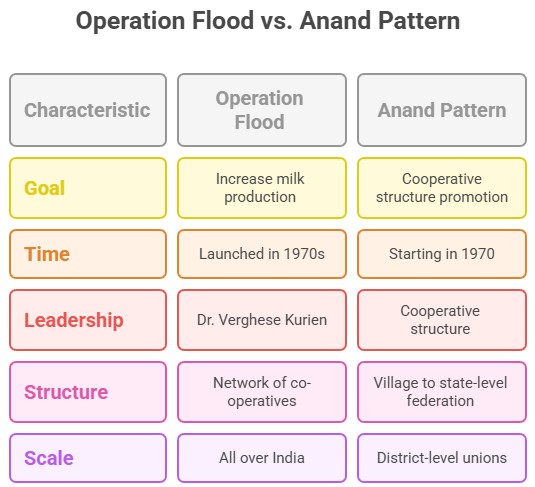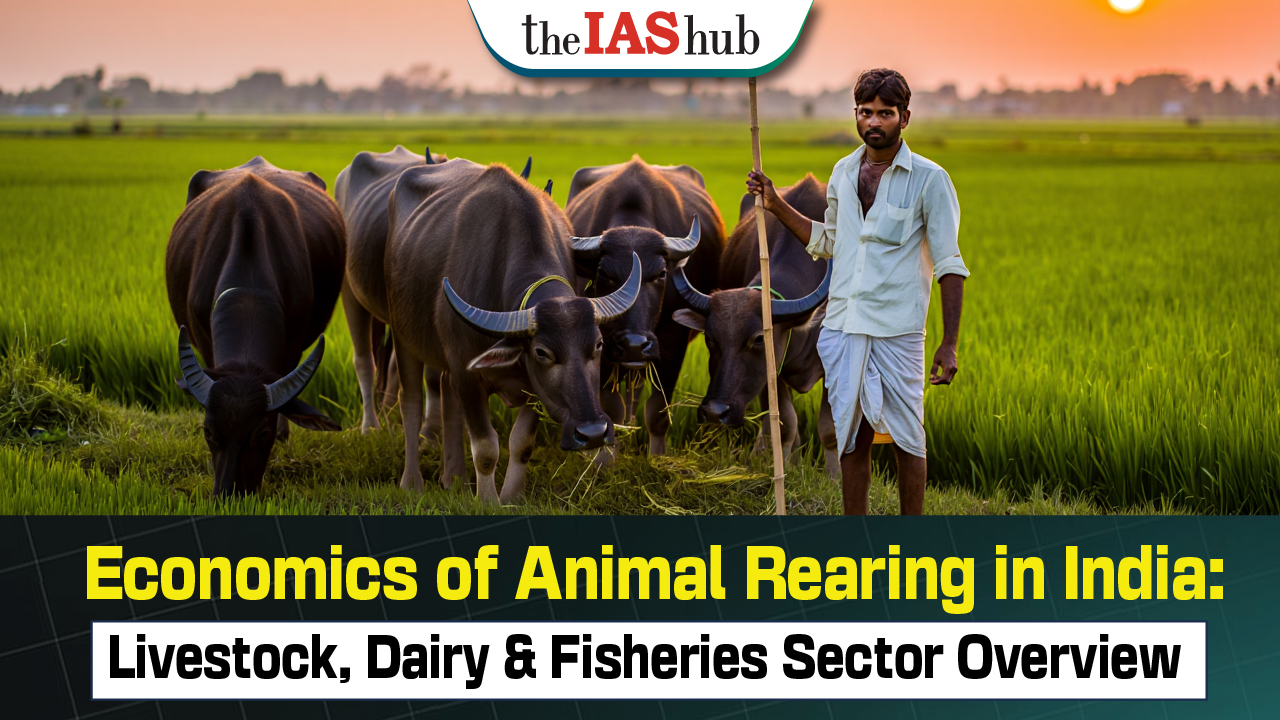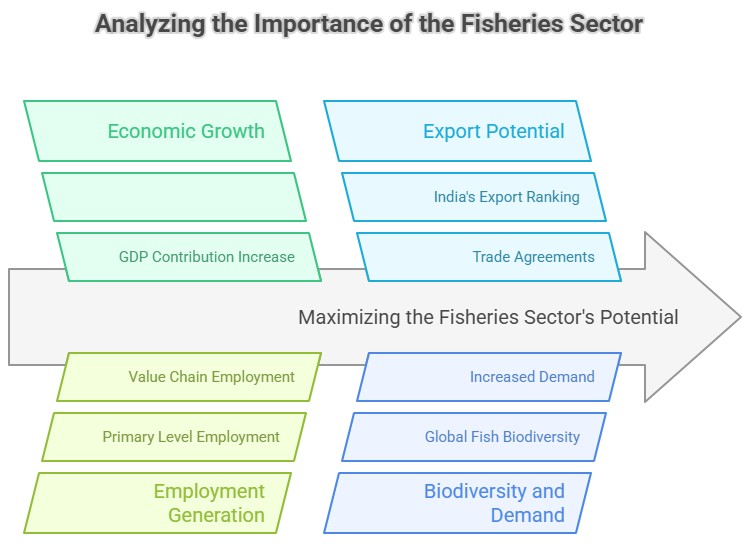Animal rearing is a vital part of India’s agricultural economy, supporting millions of rural livelihoods and contributing significantly to food security. The livestock, dairy, and fisheries sectors play a crucial role in employment, income generation, and nutrition across the country.
Economics of Animal Rearing
Livestock production and agriculture are dependent on the other and both are crucial for overall food security of the nation. Livestock sector is an important sub-sector of Indian agricultural economy. It is an integral part of livelihood activity for most of the farmers and help sustaining farm activity.
Potential of Animal Rearing in India
- About 20.5 million people depend upon livestock for their livelihood.
- Livestock contributed 16% to the income of small farm households as against an average of 14% for all rural households.
- Livestock provides livelihood to two-third of rural community.
- It also provides employment to about 8.8 % of the population in India.
- India has vast livestock resources. Livestock sector contributes 4.35% GDP and 29.35% of total Agriculture GDP.
- According to Basic animal husbandry statistics,2022 and ES 2021-22
- Total milk production in India is 221.06 mn tn
- India ranks 8th in meat production.
- India's rank in egg production is third.
- According to 20th livestock census the livestock population is 535.78 mn in country with increase of 4.6% .
- India's rank in goat and sheep population is 2nd and 3rd.
|
Challenges to Livestock Sector
- Productivity -As per Integrated Sample Survey average annual productivity of cattle in India during 2019-20 is 1777 kg per animal per year as against the world average of 2699 kg per animal per year during 2019
- Disease: Livestock are susceptible to a variety of diseases that can reduce productivity and even lead to death.
- Deficit of fodder: There is a deficit of 23.4% in the availability of dry fodder, 11.24% for green fodder and 28.9% for concentrates.
- Environmental degradation: e.g., Overgrazing, deforestation, and other forms of environmental degradation led to loss of pastureland and reduced productivity.
- Lack of infrastructure: such as roads, electricity, and water supply can make it difficult to transport feed and other inputs, and to access markets for livestock products.
- Limited access to credit- many small-scale producers have limited access to credit, which can limit their ability to expand their operations.
Government Initiatives for the Livestock Sector

How India can enhance its livestock productivity?
- Improve productivity- The effective ways to improve livestock productivity are crossbreeding, upgrading and selective breeding.
- Feed strategies strategic supplementation of limiting macro and micro nutrients, probiotics/ prebiotics, feed additives (enzymes, methane inhibitors etc.), development of Total Mixed Ration technology for improving efficiency
- Climate adaptability -The goal of increasing productivity without impacting environment can be attained through diversification and selection of inputs and management practices that foster positive ecological relationships.
- Health management - Wider and effective immunization for important economic diseases and compulsory deworming programme should be practiced. Also concepts like veterinary ambulance should be carried out.
- Processing and value addition of livestock products: Value addition of milk and milk products with the integration of fruit, vegetables and cereals has a large potential.
- Extension and training: call for delivery of services and inputs at the farmer’s door.
India with highest number of livestock have immense potential for harnessing the advantage associated with it by adopting technological solutions and prioritizing their development.
Dairy Sector
India's dairy sector is characterized by "production by masses" more than "mass production". India is the largest milk-producing country on the basis of the efforts of these small farmers with one, two or three cattle. This sector provides employment to more than 8 crore families in India. India is the Largest Producer of Milk: India contributes 23% of global milk production.
India’s dairy sector: status
|
India’s Global Position
|
Largest producer of milk in the world, since 20 years.
|
|
India’s share in Global Market
|
>20% of world’s milk production
|
|
Annual growth rate of Milk production (in last 6 years)
|
6% (growth rate of world milk production is 1.5%)
|
|
Livestock Contribution to Agriculture GDP (%)
|
25-30%
|
|
Contribution to country’s GDP
|
5%
|
|
Employment generation
|
80 million farmers directly
|
|
Per capita availability of milk (2021-22)
|
444 grams per day (more than world average)
|
|
Nature of Milk distribution industry
|
Organized sector - 40% (cooperatives & private dairies) & unorganised sector - 60%
|
|
Nature of Milk processing Industry
|
Organized sector - 20% & unorganised sector - 80%
|
Operation Flood and Anand Pattern
- Operation Flood was launched in 1970s to increase the milk production in India through network of co-operatives launched under the leadership of Dr. Verghese Kurien.
- The ‘Anand Pattern’ was essentially a cooperative structure comprising village-level Dairy Cooperative Societies (DCSs), which promote district-level unions, which in turn promote state-level marketing federation. Starting in 1970, NDDB replicated the Anand Pattern cooperatives through the Operation Flood programme all over India.

Milk production in 1950-51 stood at merely 17 million tonnes (MT). In 1968-69, prior to the launch of Operation Flood, milk production was only 21.2 MT which increased to 30.4 MT by 1979-80 and 51.4 MT by 1989-90. Now it has increased to 210 million tonnes in 2020-21.
|
Significance of Dairy Sector
- Economic Growth: The sector contributes about 5% to the country's GDP.
- Employment – 80 million households are dependent on dairy farming for livelihood.
- Tool for Inclusive growth - Livestock distribution is more equitable than land distribution. 85% of the small & marginal farmers own 45% of the land, but 75% of the bovine.
- Women Empowerment: Women have over 70% participation in the dairy sector.
- Additional Income for Farmers: About 20-30 % of the total income of farmers comes from the dairy sector.
- Savior for dryland Agriculture
- Processing demand - for cheese, paneer and other products.
- Nutritional Security - Milk contains nutrients that meet the body’s needs for calcium, magnesium, riboflavin, vitamin B12 etc.
- Sustainable agriculture by promoting integrated farming systems. For eg. Manure from dairy animals can be utilised as organic fetiliser.
Challenges to Dairy Sector
- Informal sector-large share of milk (70–85%) of marketable surplus goes through informal channel where quality is a big concern
- Farmers less share in benefits - Farmers do not share in the benefits of high demand because of poor governance of cooperatives.
- Low productivity per animal – 1,700 kg compared to global average of 2700 kg.
- Inadequate healthcare and veterinary – Frequent occurrence of deadly diseases. E.g. Foot & Mouth disease, black-leg etc. Poor veterinary services, lack of diagnostic labs, spurious medicines, etc.
- Fragmented supply- production scattered over large no of farmers at miniscule.
- Perishability- dairy requires more complex supply chain operations and logistics to ensure freshness and safety.
- Infrastructure - modern cold chain storage, transport storage facilities etc.
- Reducing grazing land- due to industrial growth.
- Fodder- availability and affordability.
- Limited financial resources - as majority dependent on small and marginal.
Creating Opportunities in Dairy Sector
- Upstream supply management- for securing a reliable, high-quality milk procurement
- Milk Processing Opportunities-Milk can be processed into a range of high-value-added products.
- Downstream supply management-need for a secure supply and a reliable distribution infrastructure
- Private participation - will boost credit supply and quality
- Processing potential - should be direct link between farmers and industries.
- Marketing - Organize traders collecting milk at the farm into groups and create joint facilities – testing, processing and storing their milk supplies.
- Promote value-addition ????Enriching milk with other nutrients and vitamins.
- Additional marketing for healthy A2A2 type milk (milk from indigenous breeds).
- Promote exports – Create rational export policy on lines of Agriculture Export Policy to enable farmers get higher prices. Adherence to international standards through mechanized and hygienic production.
- Dairy quality - Training on clean milk practices, develop milk testing infrastructure, adequate cooling facilities along with power supply, processing plant certification to build consumer confidence.
- Shift towards technology driven environment - Eg: Israeli Technology has made its country’s “Super Cows” world famous – producing more milk than any other country, up to 10.5 tons a year.
- For eg. Milk Mantra in Odisha enabled traceability and efficient supply chain management.
- Other measures – Strengthen women participation, diversify dairying to India’s Eastern Region, strengthening dairy cooperatives and encourage farmers to sell fine manure as natural fertilizer to organic farming.
Government initiatives
- Special Livestock Sector Package - Merger of Schemes into three broad categories:
- Development Programmes: It includes Rashtriya Gokul Mission, National Programme for Dairy Development (NPDD), National Livestock Mission (NLM), Livestock Census etc. as sub-schemes.
- Disease Control Programme: It is renamed as Livestock Health and Disease Control (LH & DC)
- Infrastructure Development Fund: The Animal Husbandry Infrastructure Development fund (AHIDF) and the Dairy Infrastructure Development Fund (DIDF) are merged.
- e-Gopala App - A comprehensive breed improvement marketplace & information portal for farmers.
- For Ensuring Milk Quality: Unified Dairy Mark developed by Bureau of Indian Standards.
- Dairy Entrepreneurship Development Scheme- being implemented through NABARD.
- Gopal Ratna Award 2021 – To encourage farmers, artificial insemination technicians and Dairy cooperatives.
- Quality mark - To the dairy plants of cooperatives adhering to the process standards across the dairy value chain.
- E-Pashuhaat Portal - To connect breeders and farmers regarding availability of bovine germplasm.
- Dairy Entrepreneurship Development Scheme - To generate self-employment and provide infrastructure for dairy sector.
- "Dairy Sahakar" scheme - to extend financial support by NCDC to eligible cooperatives for activities such as bovine development, branding, marketing, exports of dairy products within the overall objectives of "Doubling the farmers income" and "Atmanirbhar Bharat.
- National Animal Disease Control Programme (NADCP) -
to prevent the spread of diseases like Foot and Mouth diseases and Brucellosis among the bovines.
Dairying has become an important secondary source of income and is considered as one of the activities aimed at alleviating poverty and unemployment for marginal and women farmers especially, in the rural areas and in the rain-fed and drought-prone regions of India. The progress in this sector will result in a more balanced development of the rural economy.
Fisheries Sector
India is the 3rd largest fish producing and 2nd largest aquaculture nation in the world after China. The Blue Revolution in India demonstrated importance of Fisheries and Aquaculture sector. The sector is considered as a sunrise sector and is poised to play a significant role in the Indian economy in near future.
Status and Trends in Fisheries Sector in India
- India’s fish production hit an all-time high of 162.48 lakh ton in fiscal year 2021-22.
- India’s fish production has grown 22-fold since independence, from 7.5 lakh ton in 1950-51 to a record-breaking 162.48 lakh ton in 2021-22.
- Till 2000, marine fish production dominated India's total fish production.
- However due to practice of science-based fisheries, Inland fisheries in India has seen a turnaround and presently contributes ~70 % of total fish production.
- Inland fish production, predominantly driven by aquaculture, has witnessed an extraordinary surge. In 2000-01, inland fish production stood at 28.23 lakh tonne, which rose to 121.21 lakh tonne in 2021-22, marking a remarkable 400% increase.
Importance of Fisheries Sector
- Economic growth-The contribution of fisheries sector to the GDP/GVA has gone up from 0.46 per cent in 1950-51 to 1.24 per cent in 2018-19.
- Employment generation- The sector provides livelihood to about 16 million fishers and fish farmers at the primary level and almost twice the number along the value chain.
- Export potential - India is 4th largest fish exporting nation.
- Hunger and nutrition - fish is an affordable and rich source of Animal protein.
- Fish biodiversity - India have more than 10% of global fish biodiversity.
- Increased demand - due to increased standard of living and incomes.
Challenges of Fisheries Sector
- Unregulated fishing - overfishing without proper regulations threats sustainability.
- Infrastructure bottlenecks - insufficient cold storage and transportation.
- Lack of resource-specific fishing vessels, thus, fish stocks in deep-sea waters remain untapped.
- Weak linkages between R&D and fish farmers community - Limited number of species grown.
- Inadequate mechanization- without proper technology, freezing, transport.
- Illegal, Unreported and Unregulated (IUU) fishing - IUU fishing accounts for 40% of total marine fish catch in Indian waters.
- Bottom trawling and improper demarcation of coastal boundaries leading to disputes with neighbouring nations, For eg, Katchatheevu island dispute.
- Increased demand- is not proportional to meet the rising demand.
- Low productivity - stagnated yield
Government Initiatives
- Blue Revolution Scheme: For Integrated Development and Management of Fisheries'
- Aquaculture Infrastructure Development Fund (FIDF): For creation of fisheries infrastructure facilities both in marine and inland fisheries sectors and augment the fish production
- Pradhan Mantri Matsya Sampada Yojana (PMMSY) (2020-21 to 2024-25):
- Harnessing of fisheries potential in a sustainable, responsible, inclusive and equitable manner
- Modernizing and strengthening of value chain
- Social, physical and economic security for fishers and fish farmers
- Robust fisheries management and regulatory framework
- National Policy on Marine Fisheries, 2017' (NPMF) which provides guidance for promoting 'Blue Growth Initiative'.
- Establishment of separate Ministry for animal husbandry, dairy and fisheries in 2019
- Kisan Credit Card (KCC): Extended to fishers and fish farmers to help them meet their working capital and short-term credit needs.
Way forward
- The Meena Kumari Committee on deep sea fishing has recommended strengthening of the fisheries institutions, terms of manpower, human resource development and wherewithal.
- India will be able to optimally exploit its fisheries resources in the EEZ as also ensure that the resources are sustained and inter-generational equity is not compromised. Such an approach would also ensure realization of the ‘Blue Revolution’ from the Indian seas.
- Neel kranti to arthakranti is vision to achieve economic prosperity of country and nutritional food security of India and unleash the potential of India














